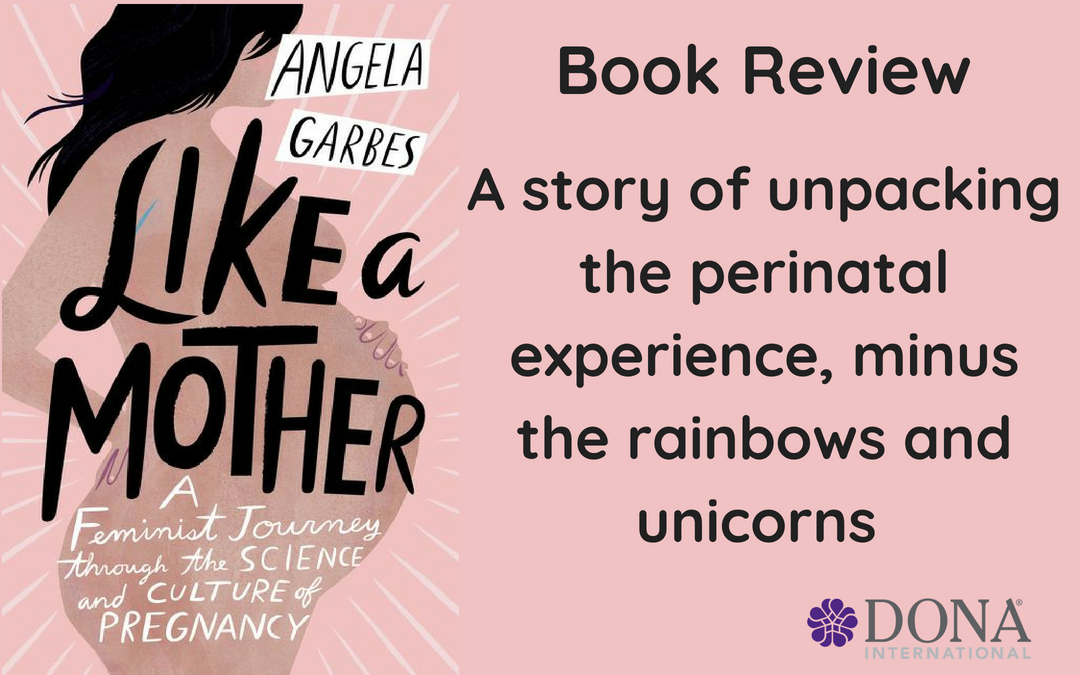By Susan Young, CD/PCD(DONA), LMT, ICCE
I love reading new books on pregnancy, labor, postpartum and parenting from authors with a unique perspective. Like a Mother (Harper Wave, 2018) is a great book that adds a valuable voice to those on the doula’s bookshelf. This book fits squarely in the camp of tell-it-like-it-really-is books that don’t sugarcoat the pregnancy through parenting continuum. The author draws heavily from her personal experience but balances this with an exploration into current scientific research on various topics. One of her goals is to unburden pregnant people from the un-sourced or outdated advice that bombards them during pregnancy. In this regard, it reminds me of Expecting Better by Emily Oster.
Addressing underrepresented families
Angela Garbes is a Seattle-based writer who employs her journalistic talents to unpack the perinatal experience. She explores a range of topics and keeps an eye towards which groups of people are not finding themselves represented in mainstream books about pregnancy. She touches on transgender experiences during pregnancy. She draws attention to racial disparities in prenatal care in the U.S. She rails against biases in funding of research which has historically excluded women and non-white populations. One thing I particularly appreciate is how all the major researchers she introduces us to in her book are female.
“In pregnancy, I didn’t quite know who I was or who I was becoming. One thing I knew, though, was that I didn’t want to lose myself.” (p.47)
A new identity
Another goal of Like a Mother is to share Garbes’ struggle to find herself throughout the perinatal journey, and by sharing, to invite readers to reflect on their own journeys. She describes a fear of losing herself, being swallowed up by the needs of her child, pre- and post-birth. Many new parents struggle with this. I remember feeling an acute loss of freedom when I became a parent. Some people we know will benefit from reading about someone else’s struggle with this experience and find validation in the author unpacking her struggle (as opposed to the constant barrage of happy posts on Facebook).
Who to recommend this book to?
I read this book quickly because I really enjoyed the clear and compelling writing, the shared perspectives and the research Garbes highlights. However, as I read, I struggled to think of who I would recommend this book to among my birth and postpartum doula clients. Doulas and other birth workers will benefit from reading it. Anatomy geeks will love it (more on that later). Those interested in feminism and a look at the perinatal experience will find value here. But what about our clients?
Many people read books covering pregnancy and labor prior to their first baby’s arrival only. Most people will benefit from books that cover more than one person’s experience, cover the nuts and bolts of labor, and explain strategies that have stood the test of time. Books like Natural Hospital Birth by Cynthia Gabriel and Ina May’s Guide to Childbirth by Gaskin fit this bill. Garbes’ book stands in a different category in my mind.
The best example of my dilemma is that this book tackles pregnancy loss in a very powerful and moving chapter. Many others have faced pregnancy loss. As a birth and postpartum doula, I found the in-depth descriptions very insightful. I feel it will make me a more informed and compassionate supporter of those who disclose to me that this has been part of their experience. Someone who reads this book during pregnancy may want a heads up, in case they choose to skip over that chapter. Someone who has experienced pregnancy loss and is in a stable place emotionally might find it very valuable to read. Another difficulty in figuring out who to recommend this book to in my client base is that her own birth story figures prominently in the book and falls outside the norm in some significant ways. It is a beautiful story of confidence, courage, and grace in accepting profound changes in plans. A book that includes lots of different birth stories would have great value to a broad audience. However, someone who wants to examine how one couple navigated their birth experience would appreciate Garbes’ personal reflections.
Realities after birth
Turning our attention to postpartum, breastfeeding and parenting, many parents ask “Why doesn’t anyone tell you how hard it is?” As doulas, in particular, I think we struggle with this balancing act. We know people will find the strength to face whatever unfolds, but we don’t want people to dread what’s ahead or to set up expectations that things will be horribly difficult when sometimes they are not. This author offers readers some refreshing realism to what it can actually be like. For example, chapter eight explores the crazy world of feeding your baby. Although she draws strongly from her personal, positive experience breastfeeding, she also includes the hopes, dreams, struggles, and disappointments of others who found it too challenging or too costly. Garbes points to research that arrived at an approximation of the monetary cost of breastfeeding – I appreciate that! She paints a vivid picture of how poorly we support the activity of breastfeeding in U.S. culture. Garbes achieved the crown jewel of non-fiction writing as she made me laugh out loud at her description of a song called “Latch” that haunted her in grocery stores and dressing rooms during her early, round-the-clock breastfeeding days.
“Before I gave birth, I naively thought that breastfeeding required less time and equipment than formula feeding. But when I returned to office work, I learned that breastfeeding also entailed the time-consuming, painstaking, accessory-heavy (and often corrosively boring) reality of breast pumping.” (p. 146)
I lived in Seattle for 15 years and appreciate its special quirkiness. Chapter nine describes a scene that I can so easily imagine unfolding in Seattle where the author found unexpected healing of her postpartum pelvic pain at “Dance Church,” a movement class that really breaks all the molds. I was laughing out loud as the author grooved to freedom in and acceptance of her new post-birth body.
The amazing birthing body
Anatomy geeks will love the chapters on the placenta and breastfeeding. Garbes sings high praise for the uterus and interrupts her dramatic birth story with a description of the microbiome. She waxes eloquently about the cervix and hormones, including Relaxin and the gang. Again, readers might enjoy this a lot, but most people trying to visualize birth for the first time will not easily find all the nuts and bolts of labor laid out sequentially in this book. It would definitely not be the only source about pregnancy, labor, birth and postpartum I would recommend.
Outside the box
Doulas often work with clients who have conflicting feelings about their experiences. We can tell them that it’s normal to feel both grateful that the baby arrived safely but disappointed that birth or postpartum didn’t unfold the way you had hoped. We can warn them that people they love may discount their conflicting feelings. But to read how Garbes navigate this may be very empowering for some readers. She shares a lot of reflections about her perinatal experience that doesn’t fit neatly into a box. That’s a real strength of the book. She demonstrates how you can shape your own birth story by choosing to remember aspects that were positive. She is generous towards her body. She makes ample room for readers to imagine conflicting feelings about postpartum adjustments too. She points to the support of others unwilling to sugarcoat things as an antidote to those feelings of failure.
“Day after day, hour after hour, your infant will remind you how little you know about what you are doing. For people who are used to doing things well, this can be more than frustrating. It can start to feel like failure.” (p. 178)
A DONA Founder and doulas are included
DONA International doulas will appreciate the author’s report of conversations with Penny Simkin. She appreciates how Penny came to see the power of how people are treated in labor as more important than other measurements of labor “success.” Garbes took Simkin’s 8-week childbirth class and also hired a birth doula. She describes how much she valued her birth doula and specific things her doula did for her that was helpful. Garbes makes a powerful case for including a doula in one’s birth plans and we don’t see that in every book on pregnancy.
One of my favorite passages in the book is her comparison of post-ACL surgery (a common knee surgery), and the therapy protocol that follows it, to the abysmal follow up we give people after birth in the U.S. She briefly highlights more robust traditions where new parent-baby dyads are nurtured and cared for. She touches on pelvic pain and dysfunction, diastasis recti and prolapse and highlights the work of postbirth health therapy. Some readers will find insights and hope in these discussions.
Conclusion
As she closes the book, Garbes circles back to the idea of whether she lost or found herself in the huge journey of becoming a parent. She concludes that through a lot of work and wonder, she accepts her new self which is shaped significantly by the events she describes. Her core is still there, familiar and strong, while her life continues to unfold. My conclusion is that many people could benefit from this book and that we all benefit from a diverse number of voices telling their stories. Those we know who have had difficulty integrating their experiences anywhere on the pregnancy-to-early parenting spectrum will find value here. Those who have a strong feminist perspective will find someone speaking their language. Anatomy geeks and Seattle fans like me, and people who want to celebrate the extraordinary transformation inherent in birth, both of baby and parents, will be enriched by this book.
About Susan Young
 Susan Young, CD/PCD(DONA), LMT, ICCE fell in love with all things birth and baby through her massage career. She lives in Houston, TX with her husband and teenage son who is learning to drive. Send good thoughts and chocolate! You can learn more about Susan from her website.
Susan Young, CD/PCD(DONA), LMT, ICCE fell in love with all things birth and baby through her massage career. She lives in Houston, TX with her husband and teenage son who is learning to drive. Send good thoughts and chocolate! You can learn more about Susan from her website.


